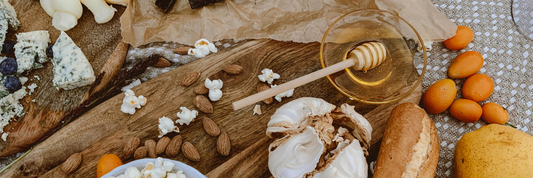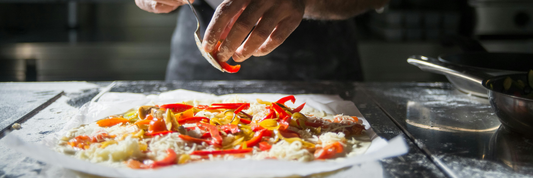Cheese sauce is a versatile kitchen staple, perfect for pasta, nachos, dips, and more. For foodservice professionals, mastering smooth, flavorful sauces ensures consistency, elevates presentation, and supports efficient, waste-conscious operations.
This guide covers key cheese sauce types, preparation tips, and sustainable serving ideas for modern foodservice.
- Can You Freeze Cheese Sauce? Complete Guide and Freezing Tips
- Cheddar Cheese Soup Recipe: Creamy & Easy to Make
- Cheesy Rice Recipe | Easy & Delicious Side Dish
What Is Cheese Sauce?

Cheese sauce is one of the most versatile components in any kitchen from cafés and caterers to restaurants and food trucks. It’s the creamy foundation that transforms simple dishes into comfort food favorites.
In essence, a cheese sauce combines melted cheese with a liquid base (usually milk or cream), thickened to a silky, pourable consistency. A good sauce should be smooth, glossy, and stable rich enough to coat pasta or vegetables, but not so thick that it clumps.
For foodservice professionals, understanding the science behind cheese sauce helps maintain consistency across large batches. The emulsification process where fat and liquid blend into a smooth texture is key. Too much heat or too little fat can cause the sauce to split.
Pro tip: Always add cheese gradually and remove the sauce from direct heat before it fully melts. Residual warmth finishes the process without curdling.
Cheese sauces are ideal for:
- Pasta dishes and baked entrées
- Dipping sauces for fries, pretzels, or vegetables
- Loaded nachos, tacos, and wraps
- Drizzling over burgers or poutine
But beyond taste, presentation and handling matter particularly for businesses offering takeaway or catering. The right serving container ensures sauces stay hot, smooth, and appetizing when they reach customers.
Types of Cheese Sauces for Every Menu
Each type of cheese sauce serves a different culinary purpose. Choosing the right one ensures consistency, flavor balance, and cost control in your kitchen.
Classic Roux-Based Cheese Sauce (Mornay or Béchamel Style)
Best for: Pasta, baked dishes, gratins.
Made with butter, flour, milk, and shredded cheese, this French-style base is stable and reheats well. Use medium-aged cheddar or Gruyère for a balanced melt and flavor.
- Keep sauce smooth by whisking constantly as milk is added.
- For a creamier texture, finish with a splash of cream or evaporated milk.
- Store warm in insulated containers to prevent a “skin” from forming.
Nacho Cheese Sauce
Best for: Fast-casual menus, snacks, take-out.
Nacho cheese is designed to stay liquid at higher temperatures perfect for dipping or drizzling. It’s typically made with mild cheddar or processed cheese blended with evaporated milk or starch for heat stability.
Add jalapeños, chili powder, or smoked paprika to give it a bold edge. This sauce works beautifully for concession stands, food trucks, or bar bites.

Vegan Cheese Sauce
Best for: Plant-based menus and lactose-free alternatives.
Vegan cheese sauces use cashews, potatoes, or nutritional yeast to replicate dairy’s creamy mouthfeel. The secret lies in the starch and fat balance: potatoes for body, nuts for richness, and yeast for umami.
For professional kitchens, vegan cheese sauce can be made in large batches and frozen in portioned cups for later service an efficient, waste-reducing prep method.
Specialty Cheese Sauces
Best for: Gourmet menus, premium sides.
These include blue cheese sauce for steaks, beer cheese for pretzels, or spicy queso blanco for Tex-Mex dishes. They elevate menu perception and pair well with craft or regional offerings.
Consistency and temperature control are vital these sauces tend to thicken quickly. Serve in paper bowls or eco-friendly containers to preserve texture.
How to Make the Perfect Cheese Sauce Recipe
Mastering cheese sauce comes down to technique. Here’s a proven workflow that professional kitchens rely on.
Step 1: Prepare the Base
Melt equal parts butter and flour (roux) over medium heat. Cook 1–2 minutes to eliminate the raw flour taste. Gradually whisk in warm milk until smooth.
For a 1-liter batch, use:
- 60 g butter
- 60 g flour
- 900 ml milk
- 250–300 g shredded cheese
Step 2: Add the Cheese Gradually
Remove from heat and stir in cheese by the handful. Use freshly grated cheese pre-shredded varieties often contain anti-caking agents that prevent smooth melting.
Step 3: Season and Adjust
Add salt, mustard, white pepper, or a touch of nutmeg for complexity. For a glossy finish, whisk in a small cube of butter at the end.
Step 4: Modify for Menu Needs
- Cheese sauce for pasta: Slightly thinner, using extra milk or cream.
- Dip or nacho cheese sauce: Slightly thicker, stabilized with cornstarch.
- Vegan cheese sauce: Blend cashews, potatoes, water, and spices; simmer until thickened.
Step 5: Maintain Quality During Service
Hold the sauce in a water bath around 65–70°C (149–158°F). Avoid direct heat, which can cause oil separation. If the sauce thickens too much, whisk in a splash of warm milk.
Storage and Handling for Foodservice Efficiency
Proper storage ensures your cheese sauce remains safe, smooth, and cost-efficient.
- Short-Term Holding:
Keep sauce hot (above 60°C / 140°F) in bain-maries or insulated containers. Stir occasionally to maintain texture. - Refrigeration:
Cool rapidly, then refrigerate below 4°C (40°F). Cheese sauce typically lasts up to 3 days. Reheat slowly over low heat, stirring constantly. - Freezing:
Cheese sauces can separate when frozen, but emulsified versions (like nacho sauce) often reheat well. Freeze in labeled, portioned containers to reduce waste. - Pro tip: Label every batch with date and type. Implement a first-in, first-out (FIFO) system to ensure freshness and food safety.
Serving Cheese Sauces Attractively and Sustainably
In today’s foodservice landscape, visual appeal and sustainability go hand-in-hand. Customers increasingly expect eco-friendly practices and sauce presentation is no exception.

Heat-Resistant, Leak-Proof Containers
Cheese sauces are high in fat and moisture, which can compromise weak packaging. Opt for containers made from bagasse (sugarcane fiber) or PLA-lined kraft materials both resist heat and grease while remaining compostable.
Portion Control and Waste Reduction
Pre-portioning sauces in small biodegradable cups helps control serving sizes and minimize leftovers. It also allows faster plating and packaging during peak hours.
Branding and Presentation
Using uniform, eco-friendly packaging communicates professionalism and environmental responsibility. Many operators print custom labels on kraft-finish lids to identify sauce type (e.g., “Vegan Cheese Dip” or “House Nacho Sauce”) enhancing visual consistency for take-out and catering.
Meeting Regulations
Canada and the U.S. continue to expand restrictions on single-use plastics. Switching to compostable packaging now ensures compliance and aligns your brand with consumer values.
Cheese Sauce Trends Shaping the Industry
Modern menus are shifting and cheese sauces are evolving to match.
Rise of Plant-Based Options
Vegan cheese sauces are no longer niche. They’re mainstream, driven by lactose-free demand and health-conscious diners. Expect more oat- or cashew-based emulsions in the coming months.
Fusion Flavors
Chefs are experimenting with global influences: miso cheese, chipotle queso, or truffle gouda sauce. These small innovations differentiate menus and attract adventurous customers.
Delivery-Optimized Recipes
Operators now design sauces for transport stability. Formulas include light thickeners or stabilizers so sauces arrive smooth after 30+ minutes in transit especially critical for pasta or nacho dishes.
Sustainability as a Selling Point
Restaurants marketing their sustainable operations including eco packaging consistently report higher repeat orders and customer satisfaction. For foodservice brands, environmental responsibility isn’t a trend; it’s part of long-term value creation.
Frequently Asked Questions (FAQs) about Cheese Sauces
What is the best cheese for a smooth cheese sauce?
Medium cheddar or processed American cheese melts evenly and gives a stable, creamy texture.
How do you stop cheese sauce from becoming grainy?
Use low heat, avoid pre-shredded cheese, and add cheese slowly off the heat.
Can I make cheese sauce ahead of time?
Yes. Cool, refrigerate, and reheat gently before serving. Add a splash of milk if thickened.
What’s the simplest vegan cheese sauce recipe?
Blend soaked cashews, nutritional yeast, lemon juice, potato starch, and water. Heat until thick and creamy.
Conclusion
Cheese sauces from classic cheddar blends to innovative vegan varieties bring warmth and comfort to countless dishes. For foodservice professionals, mastering the balance between flavor, texture, and presentation turns an everyday side into a signature experience.
Sustainable handling and serving not only protect the environment but also strengthen your brand’s culinary credibility.







